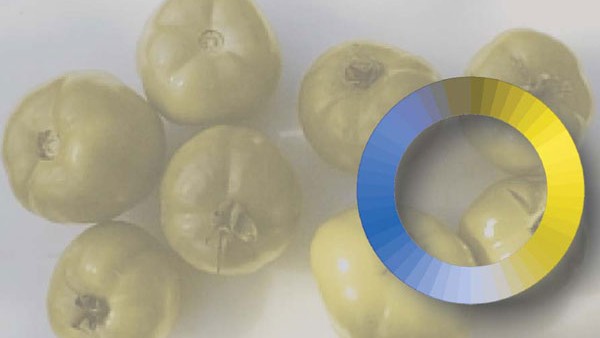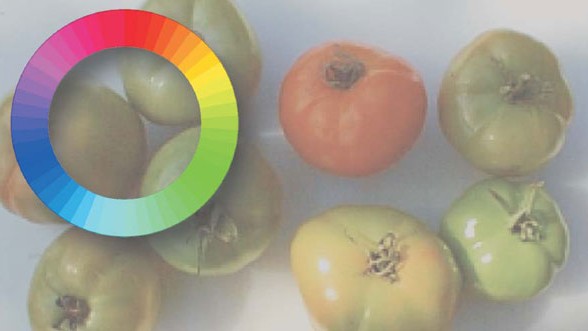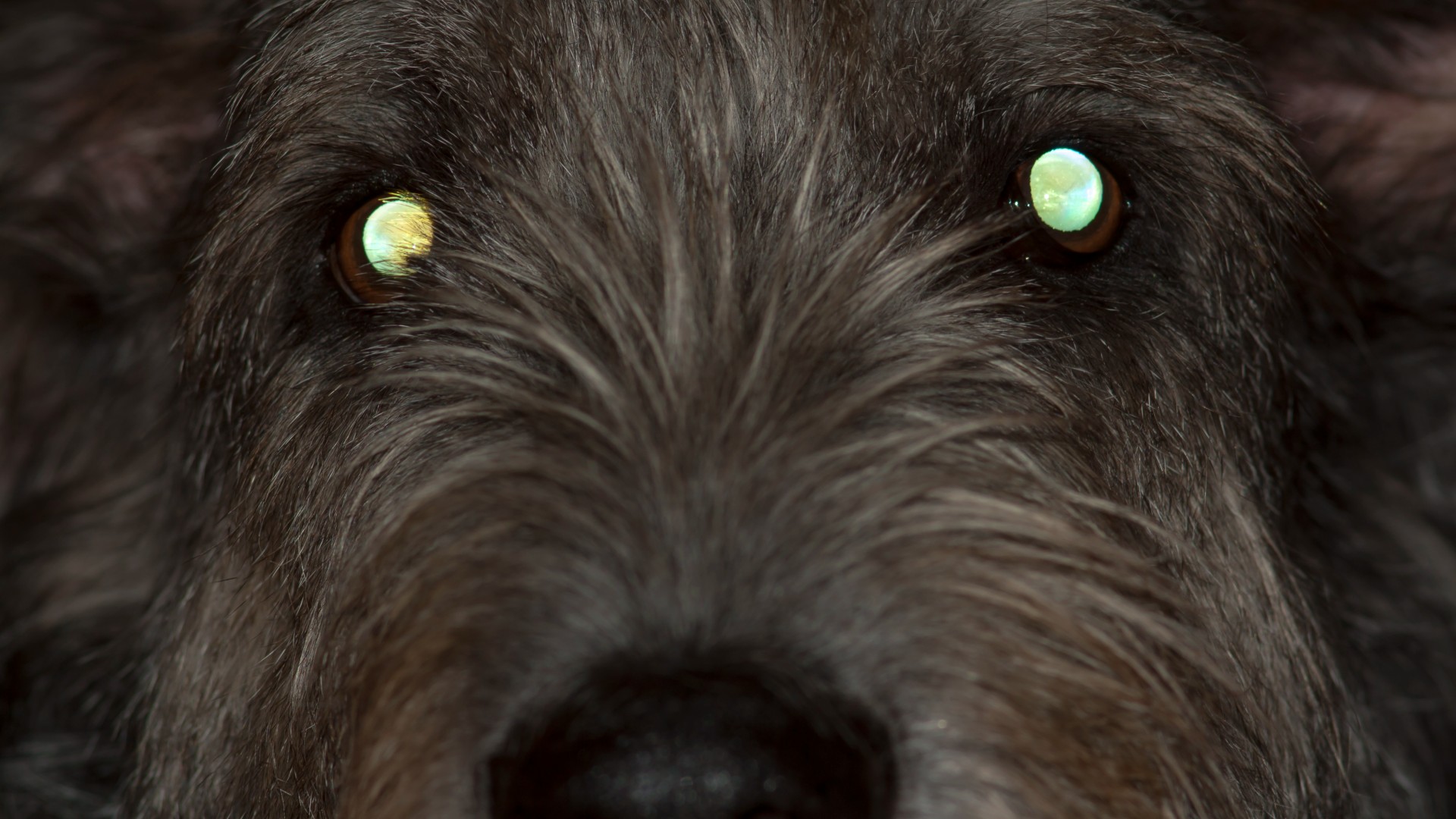What Does A Dull Grey Tapetum Indicate In Animals?
Canis familiaris vision: How do dogs run into the world?

Dog vision is very different from homo vision. Dogs see the world in fewer hues than we do, only this doesn't mean our canine companions are completely colorblind. Merely even if dogs' visual worlds are not equally articulate or every bit colorful as ours, their power to come across move is superior.
What colors can dogs encounter?
The human eye works thanks to three kinds of colour-detecting cells chosen cones. By comparing the way each of these cones is stimulated by incoming visible light, our brains distinguish ruddy wavelengths from green wavelengths and bluish wavelengths from xanthous wavelengths. Dogs' eyes, similar those of most other mammals, contain just two kinds of cones. These enable their brains to distinguish blue from yellowish, but not red from green.
Dogs are not completely colorblind, but their eyes are structured in a similar mode to those of people with blood-red-green color blindness, whose eyes also lack the third kind of cone normally present in humans, Jay Neitz, a color vision scientist at the Academy of Washington who conducted many of the modern experiments on color perception in dogs, told Live Science.
We can get an idea of what dogs run across, Neitz said, if nosotros assume their brains interpret signals from their cone cells much like the brains of people with colorblindness do.
Related: Red-green and blueish-yellow: The stunning colors you lot tin't see

To meet blue and yellow, dogs and humans rely on neurons inside a part of the centre called the retina. These neurons are excited in response to yellow light detected in the cone cells (which are likewise inside the retina), only the neurons' activity gets suppressed when blueish light hits the cones. A dog's brain interprets the excitation or suppression of these neurons as the sensation of yellow or bluish, respectively. Nevertheless, in dogs and in people who are colorblind, both ruby-red light and green calorie-free take a neutral consequence on the neurons. With no signal to interpret these colors, the dogs' brains don't perceive any color. Where you see red or dark-green, they run across shades of gray.
"A homo would be missing the sensations of red and green," Neitz said. "But whether or not the dog's sensations are missing cherry-red and green, or if their brains assign colors differently, is unclear."
Furthermore, like people with colorblindness, dogs may use other cues to distinguish the color we call "ruddy" from the color we phone call "greenish."
Related: Run across 15 crazy animal eyes

"A lot of the time, there are good cues to help them effigy it out; for instance, crimson objects tend to be darker than green objects," Neitz said. "So, if it's a dark apple, a red-green colorblind person would know that it's probably a red ane, and if it's a lighter apple, it may be a Granny Smith."
There is some evidence that dogs may be able to see colors humans cannot. A 2014 written report published in the journal Proceedings of the Royal Club B constitute that the lenses in the optics of a dog transmit significant amounts of ultraviolet light, whereas these wavelengths are blocked past human being lenses. This suggests that dogs might see more than blue calorie-free than nosotros do.
How abrupt is dog vision?
In addition to missing some of the hues perceived by human eyes, domestic dog vision lacks some of the sharpness of human vision. In a 2017 study, published in the journal PLOS One and conducted at Linköping University in Sweden, researchers designed a canine visual acuity exam similar to the tests ophthalmologists give to people. Instead of having to discern letters of decreasing size, the dogs were rewarded with treats for correctly identifying images containing vertical or horizontal lines with always-decreasing amounts of space between them.
The researchers discovered that dogs — or at to the lowest degree the whippets, pugs and the single Shetland sheepdog that participated in the experiments — were very nearsighted. The results of the experiment suggest that dogs, in well-lit conditions, take roughly 20/fifty vision. This means that they have to be 20 feet (6 meters) away from something to see it as well as a human who is fifty feet (15 m) away from that same object.
Do dogs accept night vision?
While dogs' night vision is fairly blurry, at roughly 20/250, according to the 2017 study, it is also much more sensitive than humans' dark vision. Dogs are crepuscular, meaning they tend to be nigh active at dawn and twilight, co-ordinate to the American Kennel Lodge. While human eyes are brimming-full of cones, which assist discover colors and work best in bright daylight, dogs' eyes contain more of the light-detecting cells known every bit rods, which distinguish between night and lite and thus are at their best in low-light conditions, according to the Merck Veterinary Transmission.
Related: Encounter the world from a true cat'south eyes

Many dog breeds (though non some of the toy domestic dog breeds) besides have a special eye layer, known as the tapetum lucidum, that bounces calorie-free dorsum toward their retinas, essentially magnifying the calorie-free that does reach the rods at that place, according to a 2014 written report in The Journal of Veterinarian Medical Science. The tapetum lucidum is what causes dogs' eyes to glow a blue green when light shines on them at night, according to the Merck Veterinary Manual.
The takeaway? Dogs take better night vision than humans do.
Canine motion detection
While you might think dogs alive in a dull, blurry visual world compared with ours, there is one surface area where their vision beats ours: They are much ameliorate at detecting motion. This is due to something called the critical flicker fusion rate. Imagine a light that flickers faster and faster. By the time the light is flickering 60 times per 2nd, humans volition believe the light is shining steadily. According to a 1989 study published in the journal Physiology and Behavior, that same light has to flicker roughly 75 times per second to fool a dog.
This ability likely enables dogs to spot moving objects, such as prey, much more rapidly and accurately than humans can.
Additional resources
- Detect out what your dog sees when it watches television, in this video from SciShow.
- Run across what uploaded images might look like to dogs, on this website created by neuroscientist and computer scientist András Péter.
- Take a deep swoop into the visual world of dogs in the book "Inside of a Dog: What Dogs See, Smell, and Know" (Scribner, 2010), by Alexandra Horowitz.
Bibliography
Byosiere, Due south. E., Chouinard, P. A., Howell, T. J., & Bennett, P. C. (2017). What practice dogs (Canis familiaris) see? A review of vision in dogs and implications for cognition Inquiry. Psychonomic Message & Review, 25(5), 1798–1813.
Coile, D. C., Pollitz, C. H., & Smith, J. C. (1989). Behavioral determination of critical flicker fusion in dogs" Physiology & Behavior, 45(6) 1087–1092.
Douglas, R. H. & Thou. Jeffery. (2014). The spectral manual of ocular media suggests ultraviolet sensitivity is widespread amidst mammals. Proceedings of the Majestic Society B: Biological Sciences, 281, (1780).
Hirskyj-Douglas, I. (2016, September eight). Hither'due south what dogs run across when they watch boob tube. The Conversation.
Miller, P. E., & C. J. Murphy. Vision in dogs. (1995). Periodical of the American Veterinary Medical Association, 207(12), 1623–1634.
Source: https://www.livescience.com/34029-dog-color-vision.html
Posted by: fredericksbarpries.blogspot.com

0 Response to "What Does A Dull Grey Tapetum Indicate In Animals?"
Post a Comment